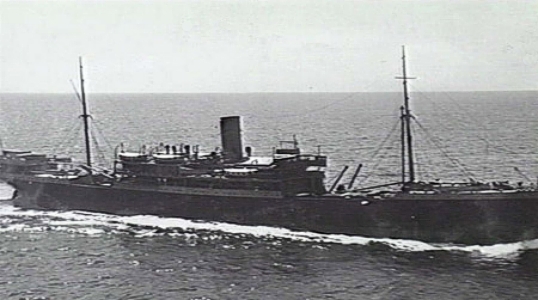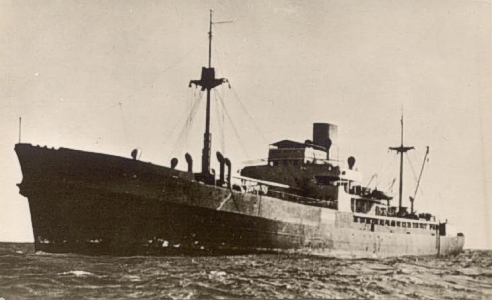|
First Part
SS Nankin
10th May 1942 - 10th July 1942

The SS Nankin, on which I was travelling as a passenger from Australia to India, was caught by a German raider on the 10th May, 1942, in about latitude 270 south, longitude 900 east.
It was a Sunday, and at about 8 o’clock in the morning, an unidentified plane was seen overhead, at a considerable altitude. It was thought by the majority of people that this unidentified plane was either a British or American plane, but during the forenoon, the Chief Officer informed me quietly that the possibility of this plane being from a raider must not be overlooked.
Shortly after lunch - about 2 p.m. - the plane came overhead again, but this time very low, in an endeavour to sweep away our aerial. We had, however, since leaving Melbourne in the SS Nankin, organised anti-submarine watchers on the upper deck, where there were also machine guns, and the people who were on the submarine watch at the time managed to keep the plane at sufficient elevation to prevent it from sweeping away our wireless aerial. It thereupon started to machine gun the ship, and very shortly afterwards the raider itself came up and started shelling. Our own gun went into action, but it was only a small gun compared with the raider’s guns, and so the raider just lay back well out of range of our gun, and then proceeded to straddle the ship from side to side and fore and aft until it got the exact range. All this time, SS Nankin was sending out an S.O.S. giving our position, and advising that we were being attacked by a raider. Eventually, the raider got our exact range, and holed us just above the waterline, on the port bow.
Thereupon, the Captain of SS Nankin, Capt. Stratford, decided, in view of the passengers, including woman and children, that he must abandon ship, which was loaded with a considerable amount of high explosives.
We took to the boats at about 2.30 p.m., having lost only two Lascars amongst SS Nankin’s crew from the shelling by the raider.
During all this time, we were under the impression that the raider was a Japanese ship, and were therefore somewhat disturbed when, with the boats in the water, the plane continued to sweep down over us, as we expected to be machine-gunned. However, we pulled towards the raider, and were considerably relieved when the raider hoisted its flag, and we saw that it was a German ship.
Before leaving SS Nankin, the engines had been put out of action, and the sea cocks opened in order to scuttle the ship, but the Germans rapidly put a prize crew aboard, and managed to save the ship, and. after a few days repaired the engines so that SS Nankin could proceed under her own power.
We were all taken aboard the raider, where there was considerable surprise to find women and children amongst the passengers of SS Nankin.
However, they managed to accommodate us all in the bottom of the hull of the raider, well below the waterline. The accommodation was naturally very cramped, and on the occasions when the forced air ventilation was not functioning, it was uncomfortably hot and stuffy. We were allowed on dock morning and afternoon for a period of one hour each, and after the first day, the food was reasonably good.
The name of the raider was not known for certain, but at the time it was thought that the ship was originally either the Rio Grande or Uginco, but from subsequent information it appeared that the name was more probably the Tura (Thor).

Thor
The raider appeared to be a ship of around 6,000 tons, with a top speed of twenty to twenty-two knots, mounting three 6” guns, together with a concealed gun which may have been of even larger calibre.
We only remained on the raider five days, transferring to the Regensburg on the 14th May. The Regensburg was a supply ship to the raider and was a N.D.L. boat. This boat had been fitted out to carry prisoners in hammocks in the ‘tween decks. On board the Regensburg there were already the survivors of four other ships - the British ships Wellpark, Willesden and Kirkpool and the Norwegian ship Aust, which had been caught and sunk by the raider in the South Atlantic. With the complement from SS Nankin, there were about 450 prisoners aboard.
We were allowed on dock all day during the hours of daylight, but after dark only two at a time were allowed to leave the ‘tween deck, for the purpose of going to the lavatory.
After a few days on the Regensburg, they commenced to transfer stores of frozen meat and other food from the “Nankin” to the Regensburg, and also to the raider, using inflated rubber rafts.
There is no doubt that SS Nankin was a very lucky catch for the raider, as the food supplies obtained therefrom enabled the raider to stay at sea much longer then would otherwise have been possible.
It seemed remarkably casual to see these three German ships sitting down in the middle of the Indian Ocean transferring food supplies, without even worrying to send up an aeroplane to make sure that there were no Allied craft in the vicinity.
On the 18th May, I was allowed five minutes aboard SS Nankin in order to collect a few items of clothing and toilet gear. This privilege was given to all civilian passengers and to the ship’s officers but was not granted to the military and naval passengers, who were aboard SS Nankin.
On the 27th May, the raider returned to the Regensburg, having been out for a week or more on a sweep looking for more victims, but came back, having caught nothing.
On the 28th May, the Regensburg parted company with SS Nankin and the raider. We started steaming in a south-westerly direction, and we all hoped that we were bound for Europe, as on that course, we anticipated that there was a reasonable hope that we might be intercepted by British blockading forces, but on the 31st May, we sighted the “Dresden”, which was a German blockade runner on route from Bordeaux to Yokohama.
All the civilian passengers from SS Nankin and the wounded and sick seamen from the other ships were then transferred from the Regensburg to the Dresden, making a total of one hundred put aboard the Dresden.
The Dresden had no proper accommodation for prisoners, so makeshift arrangements had been made to house us in the f’estle, where thirty-two of us slept in accommodation that measured 17’3” x 13’. This not only entailed the hammocks touching each other, but also the floor of the accommodation had to be used for straw mattresses for those who could not be accommodated in hammocks. The women and children were accommodated in cabins amidships.
However, despite very cramped accommodation, we wore reasonably happy, because we had been told by German Officers that we should probably be dumped in some neutral port, whence we could return to our own countries.
We steamed east in the Dresden until the 5th June, and then turned north, passing up the west coast of Australia, through the Sunda Straits, and finally reached Yokohama on the 23rd June.
When we reached Yokohama, there was apparently considerable discussion between the German and Japanese authorities as to what should be done with us.
At first the Japanese authorities refused to receive us ashore, and on the 3rd July, we were transferred to another German ship, the Ramses, a Hamburg-America boat,
On the Ramses, we found the crew of the Greek ship Pagasittikos, who had been caught by the sane raider as SS Nankin on 23/3/42 in the South Atlantic and had reached Yokohama in a German supply ship about three weeks previously.
The Ramses had been fitted out to take a considerable number of prisoners, and guns were being mounted on the bridge, and it was thought we might be returned to Germany in this ship, as there was still no arrangement for our being received by the Japanese authorities.
However, an agreement between the Germans and the Japanese was reached subsequently, and on the 10th July we went ashore, having been handed over to the Japanese.
Our general treatment, while in German hands, was quite good. A definite part of the ship was allotted to us, and we were not interfered with in our section of the ship, in any way by the German guards. It was, however, as much as our life was worth to step over these bounds, and they wore particularly emphatic that any attempt to approach the side of the ship would be met with a machine gun bullet, as they were determined that, under no circumstances, should we be allowed to drop any message over the side of the ship that might give any inkling of our position.
On board the various ships, oven on the raider, there did net seem to be any violent Nazi fanaticism or hatred towards us. In fact, the general attitude of the Germans was “It is your turn to-day; to-morrow it may be our turn”.
The Captain of the Regensburg had been a prisoner during the last war in the Isle of Wight, and the Captain of the Dresden had been a prisoner in Australia, and it may be because of this that our treatment was sympathetic. The food was, in general, adequate, as we received more or loss the same rations as the German crew.
The Captain of the Ramses, who had been in Japanese waters since the outbreak of the war with Germany, was very outspoken about German-Japanese relations and was really quite bitter when arrangements had finally been settled to hand us over to the Japanese. He stated that, if the authorities in Berlin know as much about the Japanese as the Germans did in Yokohama, there would be no question of handing over British prisoners to the Japanese for safe custody.
Apparently even at that time, when the war situation was generally favourable to both Japan and Germany, there was the most intense suspicion between the Japanese and the Germans, and all movements of Germans in Japan were very closely scrutinised, and they were, in general, subjected to the closest police supervision.
It is a matter of interest that SS Nankin was subsequently responsible for the blowing up of the raider. Apparently in October or November, 1942, the raider went to Yokohama and tied up alongside SS Nankin. While the raider was being refuelled from a tanker, a small fire broke out which spread to SS Nankin, which, with its cargo of explosives aboard, immediately blew up, and in so doing destroyed not only the raider and the tanker, but also a substantial part of the Yokohama docks. Rumours of this reached us at the time, but the details wore not obtained until after the war, when we got them from the Swiss delegate.
Next Part
Japanese POW
|